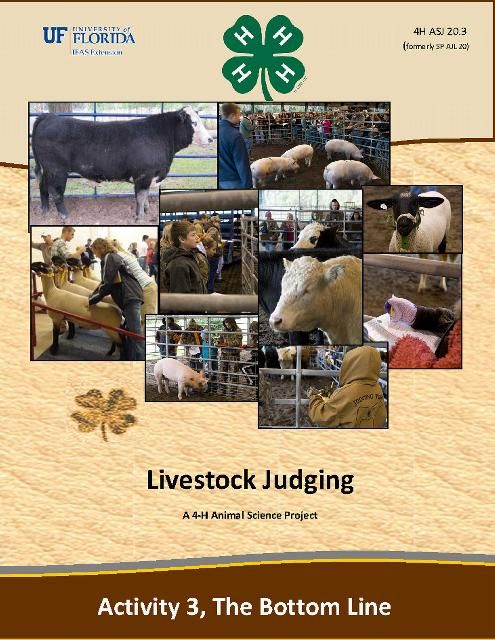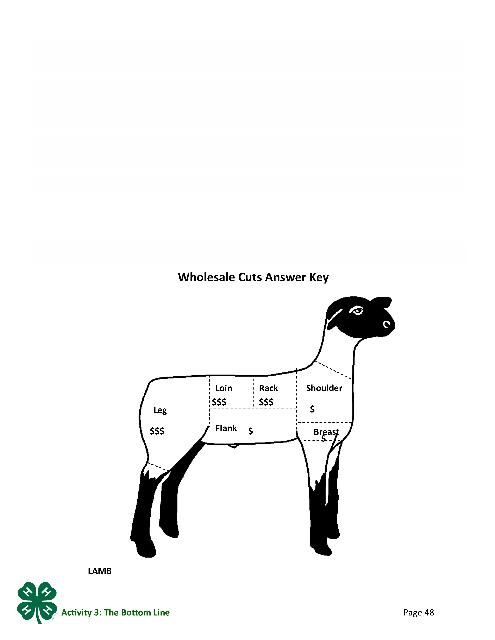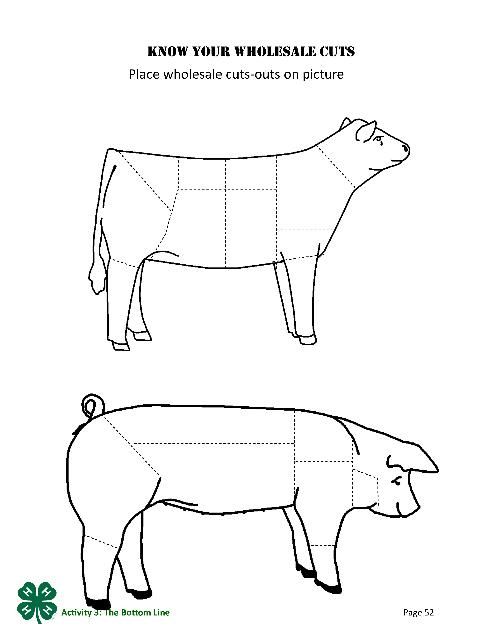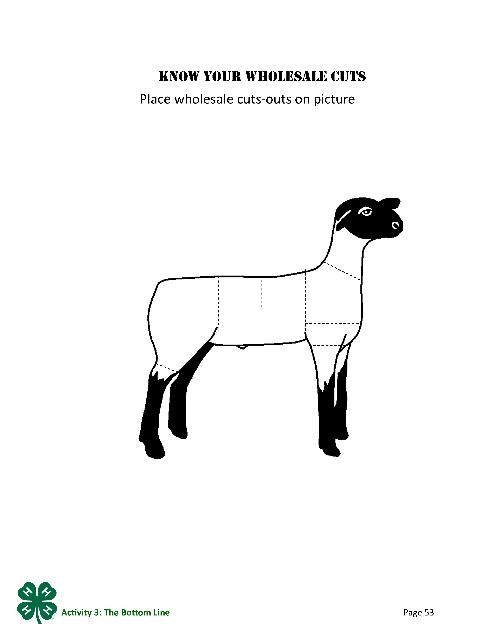
The Bottom Line
Background Basics...
The value of any slaughter animal is based upon its on-farm growth and endpoint carcass merit. For the most part, livestock industry sales are weight based. This means that a heavier animal will often be sold for more money, provided that the weight is primarily represented as muscle in the live animal. The faster producers can get an animal to reach an optimum market weight, the less feed, hay and management resources they have invested. Ultimately, this means less money and time involved in the production of that animal. For that reason, a fast growing animal is valuable to the producer. The industry also has other criteria that determine market value such as the quality of the meat products produced and the amount of red meat yield generated from an animal.
In slaughter animals, expected carcass grade and yield have the greatest influence on the price paid to the producer. Generally speaking, the carcass quality grade is a measure of quality of meat or palatability (taste), while the yield grade is a measure of quantity of meat (edible cuts). These grades are assigned to the carcass at the processing plant by a qualified meat inspector.
Beef quality grades are issued based on the age of the animal and the degree of marbling (fat within the muscle). There are eight quality grades: Prime (high), Choice, Select, Standard (low), Commercial, Utility, Cutter and Canner (lowest). Beef yield grades are issued based on the ribeye area, hot carcass weight (weight after slaughter), the amount of backfat, kidney, pelvic, and heart fat. Yield grades range from 1 to 5, with 1 yielding the highest percentage of trimmed beef from a carcass and 5 the lowest.
Pork grades are issued based on backfat thickness and a subjective muscle score (1-thin, 3-thick). A formula of [4 X backfat thickness - muscle score = USDA grade]. Pork grades are 1 to 4 with 1 yielding the highest percentage of trimmed pork from a carcass and 4 the lowest. A more accurate measurement of predicting pork yield from a market hog is called percent fat-free lean. Almost all market hogs are sold on a carcass merit system using carcass weight, loineye area, and backfat thickness to estimate percent fat-free lean. This equation will predict the percentage of closely-trimmed pork generated from a carcass, thus greater percentages indicate a greater percentage of closely-trimmed pork
Lamb is like beef in that their carcasses receive both a quality and yield grade. Lamb quality grades are issued based on maturity (age), firmness of lean and fat and a conformation score. Quality grades are Prime, Choice, Good, Utility and Cull. Lamb yield grades are a numerical representation of the expected yield of trimmed, boneless retail cuts. The yield grades range from 1 to 5 and are determined using the formula [.4 + (10 X fat over the eye) = yield grade]. A yield grade 1 lamb would yield the highest percentage of trimmed lamb from a carcass and 5 the lowest.
In breeding animals, the industry criteria is often set by the breeds. The breed association and members will select traits they would like to see enhanced or eliminated and try to produce animals with or without those traits. There is no set formula for determining the value of a breeding animal. Selection of breeding animals is often a matter of personal preference. Breeders select animals that have traits they like and hope the animal will pass those traits along to their progeny (offspring). However, the animal must be capable of reproducing.
As you can see, the industry holds the "golden key" in the livestock business. The industry can not be singled out as an individual, but is a group of people and businesses that are influenced by trade, supply of livestock, feed resources and land, demand of consumers both domestic and worldwide, value of currency, and many more factors. The producer's goal is to try to meet the changing demands of the industry, which is often not an easy task.
Introduction
The industry in which animals are expected to perform has the greatest impact on the selection of desirable characteristics. Today we will be doing a variety of exercises intended to familiarize you with the livestock industry. By playing "Let's Make A Deal", you will develop a sense of what it is like as a producer to try to meet the ever-changing demands of the industry and how important it is that the producer set goals to meet the industry's demands. By relating the wholesale cuts to the live animal, you will learn to relate money to live animal parts. In judging breeding or slaughter animals, it is imperative that you learn to compare the individual animal to the industry ideal type.
DO Play Let's Make a Deal
-
Select two to four older members from the group to serve as industry representatives and seat them at a table.
-
Give the industry representatives a copy of INDUSTRY RESPONSIBILITIES sheet and allow them time to develop a list of priorities and prices they are willing to pay for certain goods (found around the room, etc.) that other youth will present for consideration, based on their marketability or resell potential. Remember the industry is to reflect the views of the potential consumer.
-
The remainder of the group will function as the farmers, growers and producers. Their job is to find things in the room, on their body, or things they created and try to sell them to the Industry Representatives at the highest possible price. These negotiations should be done very seriously, as though the seller had something very important to lose (car, farm, house...)
-
Proceed through this part of the activity in 20-30 minutes.
Reflect
-
As a producer, how did it make you feel when something you thought was priceless was deemed worthless by the industry representatives?
-
As a producer, did you understand to locate items that would be of value to the industry in order to get a good price?
-
As an industry representative, did you sometimes feel like you wanted or needed to help the buyer with their price, but couldn't because of preset priorities?
-
What is the bottom line in the livestock industry?
Profitability
-
Do industry goals affect the individual producer?
Yes, the producer must know what kind of animal the industry demands in order to raise a marketable product.
-
Did you like this activity? Why or why not?
-
What did you learn from this activity?
Do Know Your Wholesale Cuts
-
Distribute blank animal sheets, the wholesale cuts cut-outs, and a pen/pencil to each youth.
-
Have the youth identify each wholesale cut's location for each species by gluing the cut to the animal sheet.
-
Have youth draw $$$ signs on the expensive wholesale areas, $$ signs on the intermediate value areas, and a $ sign on the least expensive wholesale areas.
-
Review the activity, have youth correct any mistakes.
-
Refer to the glossy colored inserts from the National Livestock and Meat Board, review with youth the common retail cuts from each wholesale cut.
Reflect
-
Where are the high priced retail cuts usually located on the live animal?
Most high priced cuts are found along the animal's back, such as the loin, rib, or rack.
-
Why are some cuts more expensive than others?
Cuts that contain more connective tissue (in lower leg and shoulder) will not be as tender as cuts found in the loin and upper regions of the animal. These less tender cuts often require more cooking time and have to be cooked in a moist cooking method (ie. pot roast). For this reason, people are willing to pay the extra money to have the cut that is tender and requires less cooking time.
-
Why is it important that we know this information?
-
What beef wholesale cut provides the T-bone steak?
Short Loin
Apply
-
Take an industry tour of a cattle, swine and sheep operation. Be sure to ask the host to tell specifics about their operation, industry demands and future outlook. This should not be a judging team practice class session, but an informative, reflective session.
-
Visit the meat department at a local grocery store and try to guess the wholesale cuts meat products come from.
-
Use these website resources to enhance your knowledge of meat cuts:
http://www.americanlamb.com/lamb101/cuts.aspx
http://www.virtualweberbullet.com/meatcharts_photos/lamb_cuts_poster2005.pdf
http://www.angus.org/pub/beefchart.pdf
http://www.virtualweberbullet.com/meatcharts_photos/porkcuts.pdf
Wholesale Cuts Answer Key


Let's Make a Deal
Questions Representatives Need to Answer
Would anyone want to buy this item?
How much money would they be willing to pay?
Does this item meet our quality standards?
Is there a need for this product?
Will we need to invest money in this product to be able to resell it?
How will we reach potential customers?
Set a base price you are willing to pay for an item. Consider these questions and above concerns. Be willing to negotiate, but not beyond your profit margin (difference in buying and selling price).
Industry Responsibilities
-
Establish a firm price that products are worth - be willing to negotiate with producers having large amounts of products or excellent quality products.
-
Make sure product will be able to be re-sold at a higher price.
-
Know consumer demands for type and quality.
-
Know consumer concerns, alternatives, and problems with products.
-
Give producers the highest possible price—remember you need them.
-
Sell to consumers at lowest possible price —you want them to buy your product.
-
Buy products consumers want and try to sell at the price they want.
-
Know information and price of competing products.
-
Know information on market influences droughts, floods, land shortages.
-
Know how product prices compare with other non-livestock products.
Know Your Wholesale Cuts

